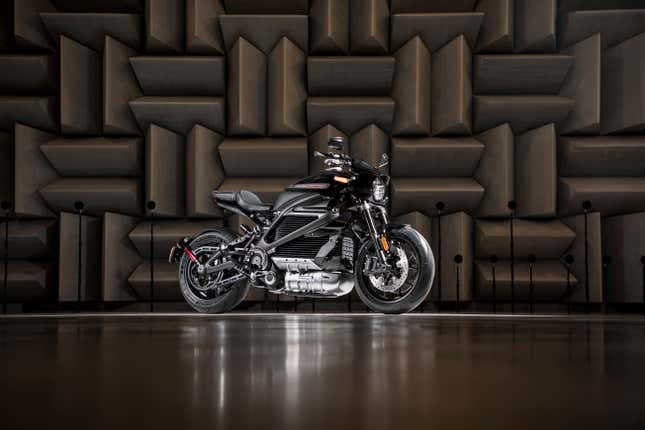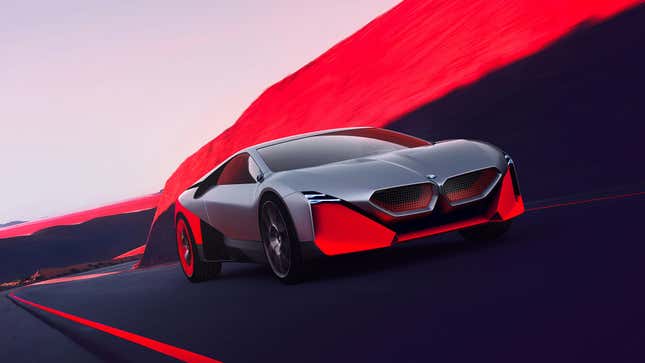Sound is a huge part of a vehicle’s personality, especially when it comes to motorcycles. As electric bikes and cars become bigger parts of the transportation ecosystem, figuring out what they’ll sound like is a big deal. Not only do electric vehicles have to be distinctive, there are safety and regulatory factors surrounding noise, too.

Both the European Union and the NHTSA in the U.S. have regulations shortly coming into effect which will require hybrid and electric vehicles—cars and motorcycles—to generate noise while traveling at low speeds. While this may just sound like another hoop auto and motorcycle makers will have to jump through to put products on pavement, some companies are seeing the situation as an opportunity to further brand and differentiate their respective battery-powered wares.
As of July 1, 2019, all new (four-wheeled) hybrid and electric vehicles sold in the European Union have to feature an “Acoustic Vehicle Alert System” (or AVAS), while all existing models must comply by July of 2021. The systems are required to generate noise when traveling at under 19 kph (12 mph) or when reversing. First passed by the European Parliament in 2014, the measure included a half-decade transitional phase that’s now come to an end.
In the U.S., a similar law will soon come into play. The only difference is that in the States, the NHTSA will require hybrid and electric vehicles to generate sounds when going less than 18.6 mph (30 kph). The regulation here extends to lightweight vehicles, including motorcycles. The measure was first cooked up back in 2013, and according to documentation provided to me by the NHTSA (and a spokesperson I talked to about the law), this rule was originally slated to kick in on September 1, 2019, though that date has been pushed back a year to September of 2020.
Ultimately these new rules are motivated by safety concerns, with the basic idea being that the artificial sounds will alert cyclists and pedestrians (particularly those who are visually-impaired) of an electric vehicle’s presence. Legislators have also asked that these sounds be communicative; changing in pitch based on a vehicle’s speed like a traditional internal combustion engine.
A Battery-Powered Future
Of course, these new regulations will only affect a small number of the world’s vehicles, as hybrids and EVs still comprise a minority of cars and bikes on the road at the moment. However, this is poised to change.
Currently more than a dozen major markets (and counting) are all aiming to ban the sale of new gas (and diesel) vehicles by 2040, or sooner in some cases, so if that comes to pass, these sound regulations will apply to pretty much every new vehicle on the road in the next few decades. Many of these plans don’t specify whether or not motorcycles are included in these bans, but India—the world’s largest motorcycle market—has revealed its plans to ban the sale of all new sub-150cc two-wheelers by 2025, and all three-wheelers by 2023.
Audio UX: What It Is And Why It Matters
To get a better sense of what’s in store for the future of electric vehicle sound, I talked to audio UX (User eXperience) designer, Connor Moore, the force behind the San Francisco-based, CMoore Sound. Moore’s clients include Google, Amazon, Uber, and Twitter, and he’s currently doing audio UX work for Tesla, so he knows a thing or two about designing sound for a vehicle.
Connor said good audio UX has to “first and foremost be communicative to its user,” intuitively guiding them through an experience. He also stressed the importance of uniformity, with the auditory alerts and tones sounding like they’re coming from the same family, relating in timbre and composition. Everything from the sounds coming from an infotainment system, to the acoustics of a door opening and closing; it’s all extremely calculated.
“A high-quality audio user experience should elevate the driving experience,” explained Moore. “It should not dominate the experience, but support the user on their journey by adding functionality in communication while also adding moments of delight that the user will remember. It should be subtle yet engaging. These small details are things, whether consciously or subconsciously, that people really notice and it influences the way they spend their time and money.”
Connor also feels the new requirements present a unique opportunity for companies to be expressive in communicating “who” they are as a brand. The audio UX designer also recognizes this as a chance to establish signature sound traits for manufacturers, which he says will become more important for brands as their products become more connected.
“I think right now many automotive and motorcycle brands are seeing the new EV regulations as an opportunity to rethink the way engines sound entirely. Most companies aren’t trying to redesign the way an internal combustion engine sounds, but are rather taking bits and pieces of those concepts and incorporating them into entirely new ideas that tend to be a bit more tonal in design. Similar to a gas engine, when a car accelerates, the volume and pitch will increase (and vice versa) though the overall tone of these engines is going to be very different. With these regulations and more EVs entering the marketplace, it’s going to be paramount for brands to design these from a strategically branded point of view.”
A Taste Of The Future
With regulations looming, quite a few automakers have already introduced artificial noise devices on their respective EV offerings. Back in 2017, Nissan unveiled its Canto concept, that “sang” as it drove and Jaguar included an AVAS in its I-PACE model. Most recently, BMW tasked film score composer extraordinaire Hans Zimmer with designing certain sound elements of the Bavarian brand’s Vision M Next Concept—more specifically the noise it makes when accelerating in Boost Mode.

With these regulations extending to two-wheelers, car companies aren’t the only ones experimenting with faux EV engine noise. Last year at EICMA, Kymco pulled the cover off its fully electric SuperNEX Concept, which not only features a clutch and six-speed manual transmission but also boasts what the Taiwanese outfit calls a “Dial-In Active Acoustic Motor.” Powered by an acoustic generator, the system “reconstructs the dynamic sound of the motor with great authenticity,” and as the name suggests, users can dial-in specific parameters of the faux engine noise. This not only provides an obvious safety benefit but is also particularly useful for communicating RPM, (considering the SuperNEX is a six-speed). It’s a stellar real-world example of how good audio UX benefits the rider.
In June of 2019, India’s Revolt Motors introduced its new RV400 (production) e-bike, which comes with four synthesized engine sounds, allowing the bike to auditorily mimic gas-powered motorcycle engines (such as a two-stroker, or a high-performance inline-four). The different exhaust notes can be selected on the fly via a Smartphone app linked to the bike, or turned off entirely (at least for the time being).
A Tricky Transition
EV noise regulations will obviously jive better with some brands than others. For firms like Harley-Davidson, for which sound is a vital and iconic aspect of its bikes, it’s to the point where the company actually attempted to copyright the sound of its motors around the turn of the millennium. The legal requirement for artificial noise is seemingly less-than-welcome news.
To better understand how Harley’s handling the auditory aspects of its electric bikes, I spoke with Glen Koval, Chief Engineer for LiveWire, Harley’s first electric model. Koval says it mainly came down to answering: How do we develop the right and appropriate sound for a soundless motorcycle?
“It wasn’t necessarily ‘let’s go make some artificial sound in the motorcycle,’” explained Koval. “It was about giving it a premium sound. We didn’t want to hear things rattling, buzzing, or other annoying wind sounds, so we start by trying to bring that premium nature out and where we felt we could differentiate was where we laid out the architecture. We have a bevel gear drive system that basically delivers power to the belt-drive and that bevel gear set was optimized to give us our signature sound on Livewire. As we build out our EV portfolio, we will be paying attention to each vehicle having characteristic sound and making sure that it fits within our DNA.“
Despite the deadline for the sound requirement only a year-or-so-away, when I inquired as to whether or not Harley was working on artificial sounds for its future electric lineup, I was told the company didn’t currently have anything in the works… at least, that they were privy to (or were at liberty to speak on). However, with the law fast approaching, it’s only a matter of time before Harley is forced to implement artificial sound in its electric bikes (regardless as to whether it coincides with H-DNA). At the same time, H-D is currently in the midst of trying to reshape the perception of who (what?) it is as a brand, and as Connor Moore points out, the new noise requirement is a “golden opportunity to be expressive in communicating” that.
A Cacophony Of Faux Sound
Those who oppose the legislation worry about where this is all leading. In the EU, officials have asked that the EV sounds be similar to traditional gas engines. Here in the States, the NHTSA is offering more flexibility. Not only did the Administration already loosen the sound requirements for the forthcoming law but, it’s also letting individual manufacturers come up with their own noises instead of using a uniform sound across the board. The NHTSA also hasn’t ruled out the possibility of allowing companies to give drivers the option of selecting from a number of different sounds.
This could easily result in major metropolitan areas turning into seas of vehicles, collectively generating a symphony of spaceship noises, beeps, chirps, and other push-notification trills. Despite the more stringent regulations in the EU, some of the noises proposed for electric buses in the UK consist of weird bubbling sounds and other annoying beeps and tones, so you can add that to the auditory mix as well. And if you think you can just turn off the AVAS on your car or bike, think again, as that won’t be an option after the law comes into effect.
On the flip side, experts like Moore worry that too much uniformity presents its own problem. “My concern is with how heavy these restrictions currently are, that many EVs will ultimately sound very similar to one another which takes the power away from the individual brands and softens differentiation in the marketplace which has been at the core of the automotive space since its inception.”
So, we might not know exactly what the coming years have in store for electric cars and motorcycles, but we can be damn sure the future of EVs won’t be a silent one.
Tim Huber is a Los Angeles-based motorcycle journalist. He’s done work for RideApart, Revzilla, The Vintagent (where he’s EV editor), Bike-urious, EatSleepRIDE (where he’s managing editor), and a few one-off stories for other outlets, both online and print.